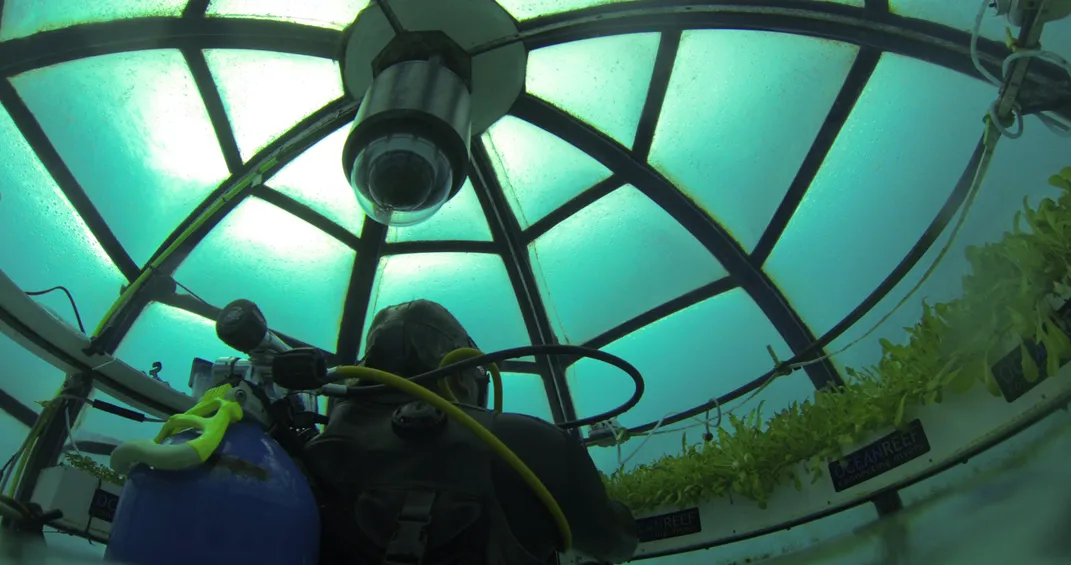Off the Coast of Italy, Two Divers Are Building Underwater Greenhouses
The biospheres could provide an alternate means of farming in regions with unstable growing conditions
Sergio Gamberini was on vacation, diving off the coast of Noli, Italy, when he decided to build his first underwater greenhouse. The scuba gear manufacturer was familiar with diving bells, the glass bell-shaped chambers that created pockets of air for descending divers before scuba systems were invented. Using the same premise, he built a mini biosphere and planted basil, as a nod to his Ligurian roots.
The biosphere was a homemade plastic bubble held stiff with metal struts and built using the technology Gamberini's company, Ocean Reef, uses to make masks. Gamberini planted the basil inside of a vase and it grew like crazy, almost twice as fast as normal. Growing plants underwater kept them at a constant temperature, but the bubble had some design flaws—it crumpled under the water pressure. So Gamberini and his son Luca have spent the past few years working out the kinks. They think the greenhouses will be a way to solve food stress in regions where growing conditions are tough, but open water is available, like offshore in the Middle East.
“We would love to be able to have an alternative way to grow plants,” says Luca Gamberini. “There are so many countries that are desperate for something like that.”
Now, in a farm called Nemo's Garden in Noli, Italy, the two men have seven biospheres anchored 20 feet underwater. The greenhouses look like bubbly space ships. They have metal frames and plastic domes, and range in volume from 50 to 3,000 liters. The gardeners are growing 15 different types of plants—basil, still, but also strawberries, herbs and lettuces. In doing so, they are trying to figure out ideal growing conditions and what plants grows best underwater.

Inside the greenhouses, humidity hovers at 95 percent, and air and water temperatures are both just under 80 degrees. Ocean Reef broadcasts the pH, humidity and oxygen levels inside the biosphere in real time. They’ve lost some crops due to flooding and rot (and once when the ropes holding the farms to the ocean floor were cut by vandals), but the yields have been decent. They've learned that leafy greens grow particularly well underwater, and they're experimenting with ways to make the biospheres self-sustaining, by using seaweed as fertilizer, for instance.
There’s skepticism from the plant physiology world that underwater environments are ideal for plant growth. Louis D. Albright, professor emeritus of biological and environmental engineering at the Controlled Environment Agriculture lab at Cornell University, thinks underwater greenhouses seem gimmicky. He worries that there will be too much humidity and not enough carbon dioxide within the greenhouse bubbles. Then, there is the pressure within the greenhouses and the logistical issues of getting people inside them to check on the plants. But his primary concern is exposure to light.
“Plants require light in different parts of the spectrum for growth and physiological development,” Albright says. “Under water, the red part of the spectrum is quickly filtered out, leaving only a very blue spectrum. [This is] not ideal for plants, [and] not even barely adequate unless one is growing seaweed.”
Gamberini will be publishing papers in the next six months to explain what he and his father are learning in their underwater plant labs. They’re presenting some of their research at Expo Milan, this year's world's fair. They installed greenhouses at the expo in June, and they'll be harvesting there through October.
He’s particularly interested in how pressure impacts plant growth. “I’m positive that there is an excessive interaction in their cellular membranes because of the pressure,” says Gamberini. “Something happens that really boosts them. It’s like putting them on steroids.”
The underwater gardeners have received requests to build the greenhouses commercially, especially from growers in coastal regions with unstable temperatures. They want to do that eventually, but in the meantime they are focused on perfecting the system before they scale up and sell it. Next spring, Ocean Reef will be selling a small-scale, 4-inch diameter Nemo’s Gardens, mostly to show people how they work. These models are fit for growing herbs in home aquariums.
/https://tf-cmsv2-smithsonianmag-media.s3.amazonaws.com/accounts/headshot/DSC_0196_2.JPG)


/https://tf-cmsv2-smithsonianmag-media.s3.amazonaws.com/accounts/headshot/DSC_0196_2.JPG)